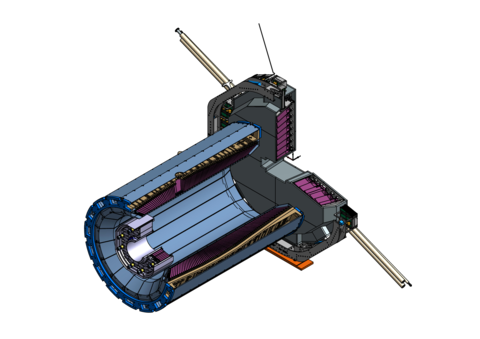Contact: Fritz-Herbert Heinsius
Good identification and a complete reconstruction of multi-photon and lepton-pair channels are of utmost importance for the success of the PANDA experiment. Low energy thresholds of 10 MeV, a good energy and spatial resolution for photons up to 15 GeV and full angular coverage are important to achieve a high yield and good background rejection. Due to the high luminosity, fast response and radiation hardness are additional requirements [1]. 
The electromagnetic calorimeter (EMC) consists of a barrel part with two endcaps in the target spectrometer and is complemented in the forward spectrometer with a shashlik type sampling calorimeter. The latter is using lead absorbers and plastic scintillator tiles, that are read out via wavelength-shifting fibers with photomultipliers and covers the most forward part of the solid angle.
The target spectrometer EMC is a homogeneous calorimeter utilizing about 15744 lead tungstate crystals (PbWO4) of 20 cm length. The second generation material, named PWO-II, has an improvement of a factor two in the light yield compared to the PWO crystals of the CMS experiment at the LHC. In addition, the calorimeter will be operated at -25 °C to gain an additional factor four in light yield. The barrel EMC (11360 tapered crystals) and the backward endcap EMC (524 straight crystals) will be readout by two large area APD (6.8 x 14 mm2) developed by Hamamatsu specifically for the PANDA experiment. For the forward endcap (3856 slightly tapered crystals), where a maximum radiation dose of up to 125 Gy per year will be accumulated at full luminosity, the inner 768 crystals will be readout with Hamamatsu vacuum phototetrodes with a diameter of 23.9 mm. The magnetic field of about 1 T at their position reduces the gain of about 50 by about a factor of two. The outer 3088 crystals will also be readout by two large area APDs.
The crystals, wrapped in a highly reflective foil, have a transversal size slightly above the Molière radius of 2.1 cm and are supported by a low mass carbon fiber alveole. Low noise and low-power charge-sensitive preamplifiers are located close to the photodetectors in the cold volume. The APFEL ASIC developed at GSI is used for the barrel and backward endcap [2]. The forward endcap with rates of up to 500 000/s utilizes a preamplifier based on discrete components developed at Basel.
A 64 channel 80 MSPS 14-bit sampling ADC constantly digitizes the signals and provides basic feature extraction. A time resolution of less than 1 ns can be achieved for energy deposits above 100 MeV.
During various test beam campaigns the energy and spatial resolutions have been measured. For example at 10 GeV and the energy resolution and the spatial resolution is 1.5% and 1.1 mm, respectively [3].
Further information can be obtained in the references.
References:
[1] Erni W et. al. (PANDA Collaboration), Technical Design Report for: PANDA Electromagnetic Calorimeter (EMC), arXiv:0810.1216v1 http://arxiv.org/abs/0810.1216v1
[2] Novotny R W, Doring W M, Hjelm F, Melnychuk D, Makonyi K, Reiter A, Salz C, Steinacher M, Thiel M and Zwieglinski B 2005 Proc. IEEE Nuclear Science Symposium, Puerto Rico, Conference Record, ISBN: 0-7803-9222-1, N12-4
[3 ] Malte Albrecht, Ruhr-Universität Bochum, Forward Endcap EMC, Calorimeter 2014, Giessen: 2015 J. Phys.: Conf. Ser. 587 012050 http://dx.doi.org/10.1088/1742-6596/587/1/012050
Internal only information on the EMC:
https://panda-wiki.gsi.de/foswiki/bin/view/EMC/WebHome




